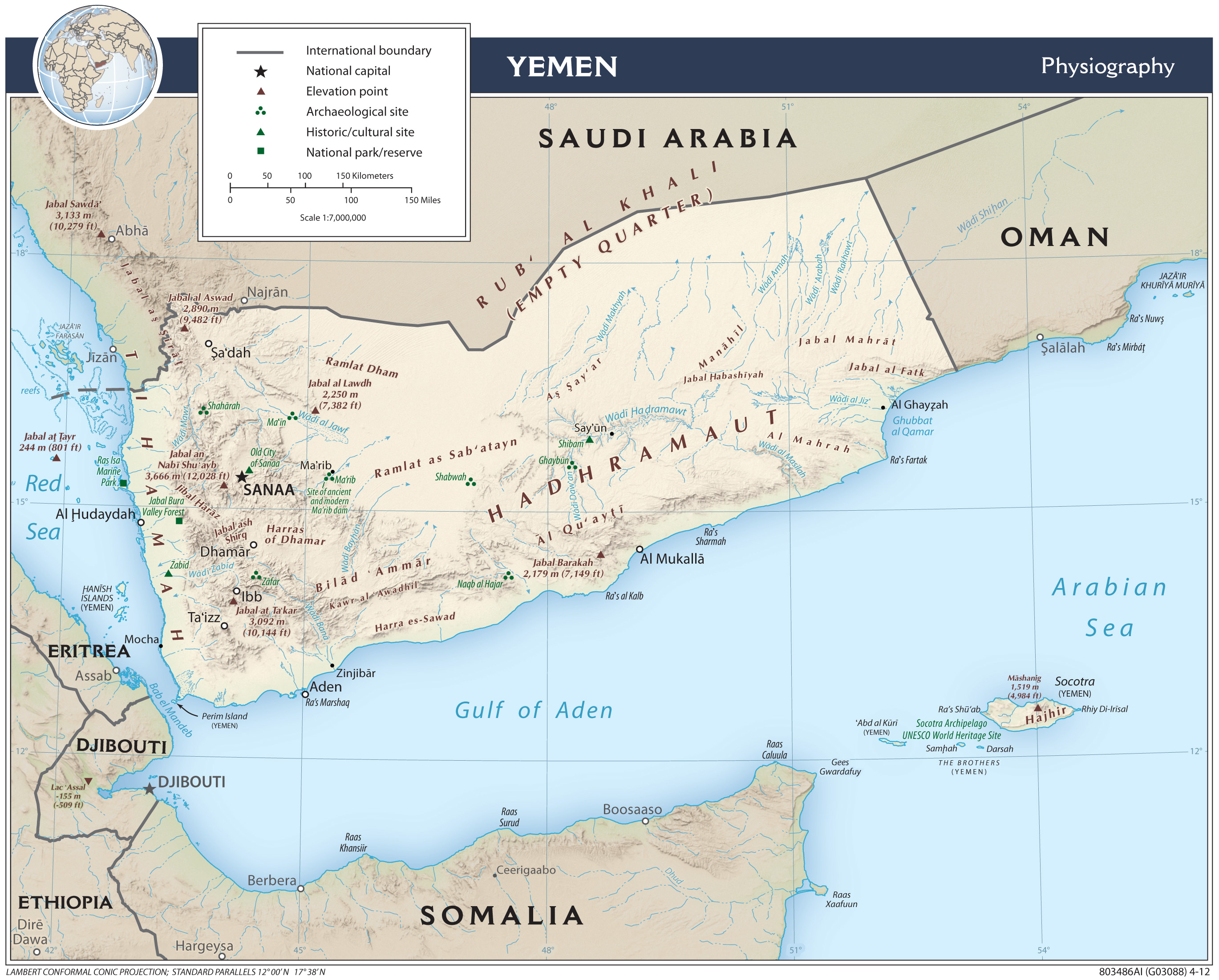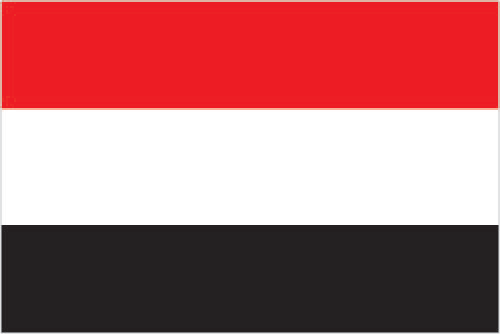| Area Total | 527,968 sq km |
| Climate | mostly desert; hot and humid along west coast; temperate in western mountains affected by seasonal monsoon; extraordinarily hot, dry, harsh desert in east |
| Natural Resources | petroleum, fish, rock salt, marble; small deposits of coal, gold, lead, nickel, and copper; fertile soil in west |
| Imports | $4.079 billion (2017 est.) partners: UAE 12.2%, China 12.1%, Turkey 8.7%, Brazil 7.3%, Saudi Arabia 6.5%, Argentina 5.5%, India 4.7% (2017) – food and live animals, machinery and equipment, chemicals |
| Exports | $384.5 million (2017 est.) partners: Egypt 29.4%, Thailand 16.7%, Belarus 13.5%, Oman 10.5%, UAE 6.5%, Saudi Arabia 5% (2017) -crude oil, coffee, dried and salted fish, liquefied natural gas |
| Government | in transition |
| Capital | Sanaa |
| Population | 28.7 million (July 2018 est.) |
| Ethnicity | predominantly Arab; but also Afro-Arab, South Asian, European |
| Language | Arabic (official); note: a distinct Socotri language is widely used on Socotra Island and Archipelago; Mahri is still fairly widely spoken in eastern Yemen |
Yemen occupies the southwest corner of the Arabian peninsula. Saudi Arabia is to its north and Oman to the east.
Within Yemen, there has traditionally been a divide between north and south. The country has only been unified since 1990. Since 2011, a civil war has been going on between the Houthis in the south and the government forces in the north. Saudi Arabia has been participating on the side of the government.
Although Yemen is poor, it has many places of historical and archaeological significance. The Queen of Sheba is said to have reigned there in ancient times.
News about Yemen
- Iran fires at suspected Israeli attack drones near Isfahan air base and nuclear siteby Jon Gambrell on April 19, 2024
Iran has fired air defenses at a major air base and a nuclear site near the central city of Isfahan after spotting drones
- IMF chief urges attention to war-ravaged Yemen, Sudanby AFP on April 18, 2024
International Monetary Fund chief Kristalina Georgieva on Thursday drew attention to the suffering in Yemen and Sudan, both plagued by civil wars and often overshadowed... The post IMF chief urges attention to war-ravaged Yemen, Sudan appeared first on Iraqi News.
- US sent seized Iran weapons, ammo to Ukraineby AFP on April 9, 2024
Washington has given Ukraine small arms and ammunition that were seized while being sent from Iranian forces to Tehran-backed rebels in Yemen... The post US sent seized Iran weapons, ammo to Ukraine appeared first on Iraqi News.
- SalamAir expands its footprint in Iraqby Amr Salem on March 17, 2024
Baghdad (IraqiNews.com) – SalamAir, the first low-cost airline in Oman, had a spectacular inauguration ceremony for its new headquarters in the Iraqi capital, Baghdad. The Ambassador of Oman to Iraq, Hamed Ahmed Eidroos, emphasized the historic moment of SalamAir’s presence in Iraq. Together with notable visitors from different authorities, airports, […]
- Huthis fire at ship off Yemen as they threaten wider campaignby AFP on March 15, 2024
A missile launched Friday by Yemen's Huthi rebels at a ship in the Red Sea caused no damage, after they threatened to expand their harassment... The post Huthis fire at ship off Yemen as they threaten wider campaign appeared first on Iraqi News.
- Missile hits ship off Yemen as rebels threaten wider campaignby AFP on March 15, 2024
A missile strike damaged a merchant ship in the Red Sea off Yemen, marine security monitors said Friday, as the country's Iran-backed Huthi rebels threatened to expand their months-long harassment... The post Missile hits ship off Yemen as rebels threaten wider campaign appeared first on Iraqi News.
- UN must block Iranian missile supply to Houthis in Yemen, UK and US sayby Patrick Wintour Diplomatic editor on March 14, 2024
Calls during Yemen briefing come as missile believed to have been launched by Houthis strikes a vessel off AdenThe US and UK have called for a UN maritime inspectorate to do more to prevent Iranian missiles reaching Houthi-controlled ports in the west of Yemen.The calls during a UN security council briefing on the crisis in Yemen came as a missile believed […]
- US urges Panama to remove flag from rogue Iranian shipsby AFP on March 13, 2024
A United States special envoy on Wednesday urged Panama to stop Iranian ships from flying its flag, which allows Tehran to... The post US urges Panama to remove flag from rogue Iranian ships appeared first on Iraqi News.
- Middle East crisis: Israel and Hamas ‘not near a truce’, says Qatar; Biden ‘devastated’ US-Israeli citizen killed in 7 October attack – as it happenedby Yohannes Lowe and Martin Belam on March 12, 2024
All parties ‘continuing to work in negotiations’, says Qatar; US president says he has heavy heart after learning of death of Itay Chen. This live blog is closedFirst aid ship to Gaza leaves Cyprus port in pilot projectA spokesperson for Yemen’s internationally recognised government told Reuters earlier that airstrikes that hit port cities and small […]
- Chinese, Russian warships join naval exercise with Iranby AFP on March 12, 2024
Chinese and Russian warships have entered Iranian territorial waters for a joint naval exercise with Iran... The post Chinese, Russian warships join naval exercise with Iran appeared first on Iraqi News.
- Red Sea crisis: US carries out six ‘self-defence’ strikes against Houthi targetsby Dan Sabbagh and agencies on March 12, 2024
Yemeni group earlier warned it would escalate operations during Ramadan in solidarity with Palestinians in GazaMiddle East crisis – live updatesThe US said it carried out six strikes in self-defence against Houthi targets on Monday afternoon and evening, hours after the rebel group warned it would escalate attacks during Ramadan in solidarity with […]
- West won’t stop Houthi attacks unless it works with Yemeni authorities, say expertsby Patrick Wintour Diplomatic editor on March 11, 2024
Calls for closer collaboration made after multiple Houthi drone strikes on ships in Red Sea over weekendMiddle East crisis – live updatesWestern efforts to stop Houthi attacks on shipping in the Red Sea will fail unless the US and its allies build stronger intelligence and military relations with the UN-recognised government in Yemen, politicians and […]
- Houthi forces step up Red Sea attacks as US and Denmark shoot down dronesby Patrick Wintour Diplomatic editor on March 9, 2024
Iran-backed group is attempting to strike ships it claims have links to Israel, in solidarity with GazaMiddle East crisis – latest updatesHouthi forces in Yemen claim to have launched one of their largest attacks on US shipping in the Red Sea and Gulf of Aden, saying they sent 37 drones to hit US navy war ships and a commercial ship.The US Central Command […]
- Expert says ‘no immediate danger’ from sunken ship off Yemenby AFP on March 8, 2024
The sinking of a bulk carrier carrying thousands of tonnes of fertiliser off Yemen after a Huthi missile attack poses "no immediate... The post Expert says ‘no immediate danger’ from sunken ship off Yemen appeared first on Iraqi News.
- Gaza war robs Muslim world of Ramadan joyby AFP on March 8, 2024
For Muslims worldwide, Ramadan is a time of prayer, reflection and joyful evening meals, but all Gazans wish for this year is an end to... The post Gaza war robs Muslim world of Ramadan joy appeared first on Iraqi News.


